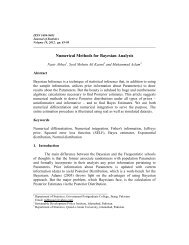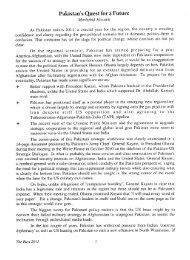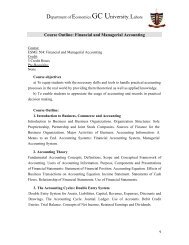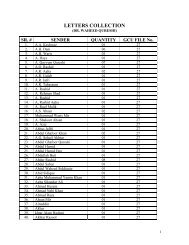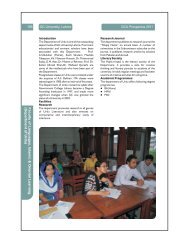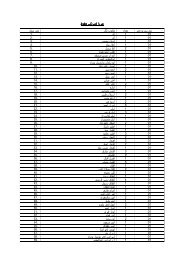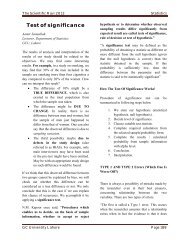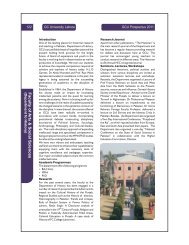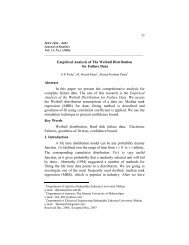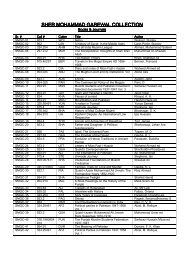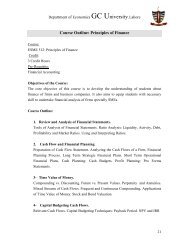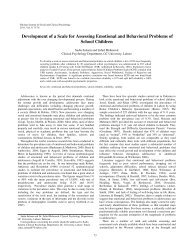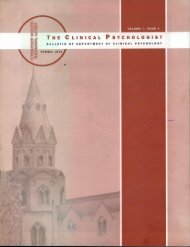Economic Reliability Acceptance Sampling Plan for Generalized ...
Economic Reliability Acceptance Sampling Plan for Generalized ...
Economic Reliability Acceptance Sampling Plan for Generalized ...
Create successful ePaper yourself
Turn your PDF publications into a flip-book with our unique Google optimized e-Paper software.
ISSN 1684-8403<br />
Journal of Statistics<br />
Volume 15, 2008, pp. 26-35<br />
________________________________________________________________________<br />
<strong>Economic</strong> <strong>Reliability</strong> <strong>Acceptance</strong> <strong>Sampling</strong> <strong>Plan</strong> <strong>for</strong> <strong>Generalized</strong><br />
Rayleigh Distribution<br />
Abstract<br />
Muhammad Aslam 1<br />
In this paper, a reliability acceptance plan is developed assuming that the lifetime<br />
of a product follows the generalized Rayleigh distribution with known value of<br />
the shape parameter. We obtain test termination ratio by considering the<br />
producer’s risk <strong>for</strong> given values of the sample size and the acceptance number. A<br />
comparison of proposed sampling plan has been made with an existing acceptance<br />
sampling plan. Two examples are given to illustrate the procedure.<br />
Keywords<br />
<strong>Acceptance</strong> sampling, <strong>Reliability</strong> sampling plan, Life test, <strong>Generalized</strong> Rayleigh<br />
distribution, Sample size<br />
1. Introduction<br />
The Rayleigh distribution was derived by Rayleigh (1880) to handle problems in<br />
the field of acoustics. The Rayleigh distribution has many applications in life<br />
testing of electro-vacuum devices (Polovko, 1968) and in communication<br />
engineering (Dyer and Whisenand, 1973). Tsai and Wu (2006) developed an<br />
acceptance sampling plan assuming that the life time of a product has a<br />
generalized Rayleigh distribution. They found the minimum sample size and the<br />
minimum ratio of true average life to specified average life 0<br />
. The cumulative<br />
distribution function (cdf) of the Rayleigh distribution is:<br />
2 2<br />
F ( t;<br />
b)<br />
1<br />
exp( t<br />
/(2b<br />
)), t 0,<br />
(1.1)<br />
1 Department of Statistics, National College of Business Administration & <strong>Economic</strong>s, Lahore,<br />
Pakistan<br />
Email: aslam_ravian@hotmail.com
<strong>Economic</strong> <strong>Reliability</strong> <strong>Acceptance</strong> <strong>Sampling</strong> <strong>Plan</strong> <strong>for</strong> <strong>Generalized</strong> Rayleigh Distribution<br />
_______________________________________________________________________________<br />
where b>0 is the scale parameter. The failure rate is an increasing linear function<br />
of time, which makes it suitable <strong>for</strong> modeling the lifetime of electronic<br />
components. Voda (1976) derived a generalized version of the Rayleigh<br />
distribution called the generalized Rayleigh distribution (GRD), whose cdf is<br />
given by:<br />
2<br />
k 2 j t<br />
/ <br />
( t / )<br />
e<br />
Fk<br />
( t;<br />
) 1<br />
<br />
,<br />
(1.2)<br />
j0<br />
j!<br />
where k is a positive integer called the shape parameter and λ>0 is the scale<br />
2<br />
parameter. When k=0 and 2b , the cdf given in (1.2) reduces to (1.1). The ith<br />
moment of the random variable T having GRD is:<br />
<br />
1/2<br />
i<br />
ki/ 2 1<br />
i/2<br />
[ ] <br />
, i 1,2,....<br />
1/2<br />
E T<br />
<br />
<br />
k 1<br />
So the mean of GRD is given by:<br />
<br />
<br />
27<br />
(1.3)<br />
1/2<br />
E[ T]<br />
m<br />
(1.4)<br />
where m k 3/ 2 k<br />
1<br />
.<br />
The quality of the product is tested on the basis of few items taken from an<br />
infinite lot. The statistical test can be stated as: Let be the true average life and<br />
<br />
0<br />
be the specified average life of a product. Based on the failure data, we want<br />
to test the hypotheses H : against H : <br />
0 0<br />
1 0<br />
. A lot is considered as good<br />
if 0<br />
and bad if 0<br />
. This hypothesis is tested using the acceptance<br />
sampling scheme as: In a life test experiment, a sample of size n selected from a<br />
lot of products is put on the test. The experiment is terminated at a pre-assigned<br />
timet 0<br />
. When we set acceptance number as c , H<br />
0<br />
is rejected if more than c<br />
failures are recorded be<strong>for</strong>e timet 0<br />
. If there are c or fewer failures be<strong>for</strong>e t 0<br />
, then<br />
H<br />
0<br />
is accepted. Producer’s risk and the consumer’s risk are associated with<br />
acceptance sampling. The probability of rejecting a good lot is called the<br />
producer’s risk say and the probability of accepting a bad lot is known as<br />
consumer’s risk, say . A well acceptance sampling plan minimizes both the<br />
risks.
28<br />
Aslam<br />
_______________________________________________________________________________<br />
Truncated life tests of this type have been developed by Sobel and Tischendrof<br />
(1959), Goode and Kao (1961) <strong>for</strong> Weibull distribution, Kantam and Rosaiah<br />
(1998) <strong>for</strong> half logistic distribution, Kantam et al. (2001) <strong>for</strong> log-logistic<br />
distribution, Baklizi (2003) <strong>for</strong> the Pareto distribution of the second kind, Rosaiah<br />
and Kantam (2005) <strong>for</strong> inverse Rayleigh distribution, Rosaiah et al. (2006) <strong>for</strong><br />
exponentiated log-logistic distribution, Rosaiah et al. (2007) developed the<br />
reliability plans <strong>for</strong> exponentiated log-logistic distribution, Aslam (2007) <strong>for</strong> the<br />
Rayleigh distribution, Balakrishnan et al. (2007) <strong>for</strong> the generalized Birnbaum-<br />
Saunders distribution, Aslam and Shahbaz (2007) <strong>for</strong> the generalized exponential<br />
distribution, Rosaiah et al. (2008) <strong>for</strong> the inverse Rayleigh, and Aslam and<br />
Kantam (2008) <strong>for</strong> the Birnbaum-Saunders distribution. We propose a reliability<br />
acceptance sampling plan when the lifetime of a product follows the generalized<br />
Rayleigh distribution. Further, it is assumed that the shape parameter of this<br />
distribution is known. The rest of the paper is organized as: design of the<br />
proposed plan is given in Section 2, the comparative study with existing plan is<br />
given in Section 3. Some Tables are given at the end of the paper.<br />
2. Design of Proposed <strong>Plan</strong><br />
We are interested in designing a sampling plan which ensures that the true<br />
average life is greater than the specified average life. We propose the following<br />
acceptance sampling plan based on truncated life test:<br />
i. Select n d r ( r c 1, d 2,3, ) items and put them on test.<br />
ii. Select the acceptance number c and termination timet 0<br />
.<br />
iii. Terminate the experiment if more than c failures are recorded be<strong>for</strong>e<br />
termination time and reject the lot. Accept the lot if c or fewer failures<br />
occur be<strong>for</strong>e termination time.<br />
Suppose that the lifetime of a product follows the GRD with cdf given in (1.2). It<br />
would be convenient to determine the termination time t0<br />
as a multiple of the<br />
specified average life 0<br />
. We assume that the lot size is large enough so that the<br />
binomial theory can be applied. Thus the acceptance or rejection criterion of the<br />
lot is equivalent to the acceptance or rejection of the hypothesis that 0<br />
. For<br />
more justification about the use of the binomial distribution in proposed plan, one
<strong>Economic</strong> <strong>Reliability</strong> <strong>Acceptance</strong> <strong>Sampling</strong> <strong>Plan</strong> <strong>for</strong> <strong>Generalized</strong> Rayleigh Distribution<br />
_______________________________________________________________________________<br />
may refer to Stephens (2001). The lot acceptance probability is given as:<br />
c<br />
n<br />
i ni<br />
L(<br />
p)<br />
p<br />
(1 p)<br />
,<br />
(2.1)<br />
i0<br />
i <br />
where p is the probability that an item fails be<strong>for</strong>e termination time and is given<br />
by:<br />
2<br />
<br />
2 j am <br />
am<br />
<br />
<br />
<br />
0<br />
<br />
e <br />
k <br />
<br />
<br />
<br />
0<br />
p 1 <br />
<br />
.<br />
(2.2)<br />
j0<br />
j!<br />
<br />
<br />
<br />
<br />
<br />
<strong>for</strong> k =0, 1 and 2 m is 0.886227, 1.32934 and 1.66168, respectively.<br />
29<br />
Now, we find the minimum termination ratio <strong>for</strong> some specified producer’s risk,<br />
sample size n r d and the acceptance number d<br />
c 1<br />
when the following<br />
inequality is satisfied:<br />
n<br />
<br />
ir<br />
n<br />
i<br />
ni<br />
p0 ( 1 p0<br />
) 1<br />
.<br />
i <br />
(2.3)<br />
Tables 1-3 represent the termination time according to various values of shape<br />
parameter, acceptance number, sample size and two values of producer’s risk. It is<br />
clear from the Table 1 as the sample size increases <strong>for</strong> fixed value of r , the<br />
termination ratios decrease. If shape values increase, the termination ratio also<br />
increases. For example, when r 4, n 40 , k 0 and =0.05, the termination<br />
ratio is 0.213. Keeping the other quantities same and k 1, the termination ratio<br />
is 0.405.<br />
3. Comparative Study<br />
The upper entry in each cell of Table 4 corresponds to the proportion of t 0<br />
a<br />
of the proposed test plan with k 0 . The lower entry corresponds to the similar<br />
quantity of the sampling plan of Tsai and Wu (2006). These entries reveal that the<br />
termination ratio of the proposed test plans is smaller than they are <strong>for</strong> the plans in<br />
Tsai and Wu (2006).
30<br />
Aslam<br />
_______________________________________________________________________________<br />
Example 1<br />
Suppose that the life time of a product follows the GRD with k 0 . An<br />
experimenter wants to run an experiment at t =1500 hours ensuring that the<br />
specified average life is at least 1000 hours. This leads to the termination ratio<br />
1.5. Let the producer’s risk be 0.05. The corresponding values of n and c from<br />
Table 1 of Tsai and Wu (2006) are 4 and 1, respectively. The sampling plan<br />
( n 4, c 1, t 0<br />
1.500) is stated as: if during 1500 hours no more than 1 failure<br />
out of 4 is recorded, the lot is accepted, otherwise rejected. For the same sampling<br />
plan the termination ratio from Table 1 is 0.362. Thus, the proposed plan will be<br />
( n 4, c 1, t0 0<br />
0.362) which is implemented as: We reject the product if<br />
more than 1 failure is observed during the 362 hours, otherwise we accept it.<br />
In both approaches the acceptance number, the sample size, the producer’s risk<br />
and the final decision about the lot are the same. But the decision on the first<br />
approach equates to 1500 st hours and in the second approach, it equates to 362 st<br />
hours. Hence, the proposed approach is preferable to that of the first approach.<br />
Example 2<br />
Consider a problem associated with reliability provided by Wood (1996) and<br />
analyzed from the acceptance sampling viewpoint by Rosaiah and Kantam<br />
(2005), Rosaiah at al. (2007) and Balakrishnan et al. (2007). The ordered failure<br />
times of the release of software given in terms of hours from the starting of the<br />
execution of the software are regarded as ordered sample of size 14 with the<br />
x i . The ordered data are 519, 968, 1430, 1893,<br />
failure times as , ( 1,2,..,14)<br />
i<br />
2490, 3058, 3625, 4422, 5218, 5823, 6539, 7083, 7487, and 7846.<br />
First we check whether the GRD can be used or not <strong>for</strong> the above data. The MLE<br />
of ˆ is 13321429. The Kolmogorov-Smirnov distance between the observed and<br />
fitted distribution is 0.2447 which is less than the Kolmogorov-Smirnov Table<br />
value of 0.314. Hence, it is reasonable to assume that lifetime of this product<br />
follows GRD with k=0.<br />
Case I:<br />
Suppose that the specified average life of software product is 1000 hours. Let the<br />
producer’s risk be 0.01. The termination time to test the product from Table 1 of<br />
Tsai and Wu (2006) is 800 hours with corresponding c 1. Then the acceptance<br />
plan is ( n 14, c 1, t 0<br />
.8) . According to existing plan the product is rejected
<strong>Economic</strong> <strong>Reliability</strong> <strong>Acceptance</strong> <strong>Sampling</strong> <strong>Plan</strong> <strong>for</strong> <strong>Generalized</strong> Rayleigh Distribution<br />
_______________________________________________________________________________<br />
if more than 1 failure is observed during 800 hours. The experiment is<br />
terminated if 2 failures occur be<strong>for</strong>e 800 hours; or end time of the experiment,<br />
whichever occurs earlier. From the data we see that only one failure occurs<br />
be<strong>for</strong>e 800 hours, there<strong>for</strong>e we accept this product with 99% confidence.<br />
Case II:<br />
From Table 1, the value of termination ratio is 0.115 <strong>for</strong> the same software data<br />
as in Example 2. Since the acceptable average life is to be 1000 hours, we get<br />
t0 0.1151000 115 hours (approximately). The proposed sampling plan is<br />
( n 14, c 1, t0 0<br />
.115) . We put 14 items on test. The lot of product will be<br />
accepted if no more than 1 failure occurs be<strong>for</strong>e 115 hours. In this approach we<br />
see that among 14 failures, there is no failure be<strong>for</strong>e 115 hours, there<strong>for</strong>e we<br />
accept the product.<br />
Acknowledgements<br />
The author would like to thank the reviewers and Editors <strong>for</strong> several valuable<br />
comments.<br />
References<br />
1. Aslam, M. (2007). Double acceptance sampling based on truncated life tests<br />
in Rayleigh distribution. European Journal of Scientific Research, 17(4),<br />
605-611.<br />
2. Aslam, M. and Kantam, R. R. L. (2008). <strong>Economic</strong> acceptance sampling<br />
based on truncated life tests in the Birnbaum-Saunders distribution. Pakistan<br />
Journal of Statistics, 24(4), 269-276.<br />
3. Aslam, M. and Shahbaz, M. Q. (2007). <strong>Economic</strong> reliability tests plans using<br />
the generalized exponential distribution, Journal of Statistics, 14, 52-59.<br />
4. Baklizi, A. (2003) <strong>Acceptance</strong> sampling based on truncated life tests in the<br />
Pareto distribution of the second kind. Advances and Applications in<br />
Statistics, 3 (1), 33-48.<br />
5. Balakrishnan, N., Leiva, V. and Lopez, J. (2007). <strong>Acceptance</strong> sampling plans<br />
from truncated life tests based on the generalized Birnbaum-Saunders<br />
distribution. Communication in Statistics-Simulation and Computation, 36,<br />
643-656.<br />
6. Dyer, D. D. and Whisenand, C. W. (1973). Best linear unbiased estimator of<br />
the parameter of the Rayleigh distribution-Part I: Small sample theory <strong>for</strong><br />
censored order statistics, IEEE Transaction on <strong>Reliability</strong>, 22, 27-34.<br />
31
32<br />
Aslam<br />
_______________________________________________________________________________<br />
7. Goode, H. P. and Kao, J. H. K (1961). <strong>Sampling</strong> plans based on the Weibull<br />
distribution, Proceedings of the Seventh National Symposium on <strong>Reliability</strong><br />
and Quality Control, Philadelphia, Pennsylvania, 24-40.<br />
8. Kantam, R.R. L. and Rosaiah, K. (1998). Half logistic distribution in<br />
acceptance sampling based on life tests, IAPQR Transactions, 23(2), 117-125.<br />
9. Kantam, R.R.L., Rosaiah, K. and Srinivasa Rao,G. (2001). <strong>Acceptance</strong><br />
sampling based on life test: log-logistic model, Journal of Applied Statisics,<br />
28(1), 121-128.<br />
10. Polovko, A. M. (1968). Fundamentals of <strong>Reliability</strong> Theory. Academic Press,<br />
New York.<br />
11. Rayleigh, J. W. S. (1880). On the resultant of a large number of vibrations of<br />
the same pitch and of arbitrary phase, Philosophical Magazine, 5 th series, 10,<br />
73-78.<br />
12. Rosaiah, K. and Kantam, R.R.L. (2005). <strong>Acceptance</strong> <strong>Sampling</strong> Based on the<br />
Inverse Rayleigh Distribution, <strong>Economic</strong> Quality Control, 20(2), 277—286.<br />
13. Rosaiah, K., Kantam, R. R. L. and Reddy, J. R. (2008). <strong>Economic</strong> reliability<br />
test plan with inverse Rayleigh variate, Pakistan Journal of Statistics, 24, 57-<br />
65.<br />
14. Rosaiah, K., Kantam, R.R.L. and Santosh Kumar, Ch. (2006) <strong>Reliability</strong> of<br />
test plans <strong>for</strong> exponentiated log-logistic distribution, <strong>Economic</strong> Quality<br />
Control, 21(2), 165-175.<br />
15. Rosaiah, K., Kantam, R.R.L. and Santosh Kumar, Ch. (2007). Exponentiated<br />
log-logistic distribution- An economic reliability test plan, Pakistan Journal of<br />
Statistics, 23(2), 165-175.<br />
16. Sobel, M. and Tischendrof, J. A. (1959). <strong>Acceptance</strong> sampling with new life<br />
test objectives, Proceedings of Fifth National Symposium on <strong>Reliability</strong> and<br />
Quality Control, Philadelphia, Pennsylvania, 108-118.<br />
17. Stephens, K. S. (2001). The Handbook of Applied <strong>Acceptance</strong> <strong>Sampling</strong>:<br />
<strong>Plan</strong>s, Procedures and Principles, ASQ Quality Press, Milwaukee, WI.<br />
18. Tsai, Tzong-Ru and Wu, Shuo-Jye (2006). <strong>Acceptance</strong> sampling based on<br />
truncated life tests <strong>for</strong> generalized Rayleigh distribution, Journal of Applied<br />
Statistics, 33(6), 595-600.<br />
19. Voda, V. Gh. (1976). Inferential procedures on a generalized Rayleigh variate,<br />
I, Aplikace Mathematiky, 21, 395-412.<br />
20. Wood, A. (1996). Predicting software reliability, IEEE Transactions on<br />
Software Engineering, 22, 69-77.
<strong>Economic</strong> <strong>Reliability</strong> <strong>Acceptance</strong> <strong>Sampling</strong> <strong>Plan</strong> <strong>for</strong> <strong>Generalized</strong> Rayleigh Distribution 33<br />
_______________________________________________________________________________<br />
Table 1: Test termination ratios under GRD with k 0<br />
r n 2r<br />
3r 4r 5r 6r 7r 8r 9r 10r<br />
0.05<br />
1 0.181 0.147 0.127 0.114 0.104 0.097 0.090 0.085 0.081<br />
2 0.362 0.287 0.246 0.218 0.197 0.183 0.171 0.160 0.152<br />
3 0.459 0.362 0.308 0.272 0.248 0.228 0.212 0.197 0.189<br />
4 0.522 0.407 0.346 0.307 0.278 0.256 0.239 0.225 0.213<br />
5 0.566 0.441 0.374 0.331 0.299 0.276 0.257 0.234 0.228<br />
6 0.599 0.465 0.394 0.348 0.315 0.290 0.269 0.254 0.240<br />
7 0.624 0.484 0.409 0.361 0.328 0.302 0.281 0.264 0.249<br />
8 0.645 0.499 0.422 0.373 0.346 0.311 0.289 0.272 0.257<br />
0.01<br />
1 0.079 0.064 0.055 0.051 0.046 0.043 0.039 0.038 0.036<br />
2 0.233 0.186 0.159 0.141 0.126 0.115 0.108 0.102 0.097<br />
3 0.335 0.264 0.225 0.197 0.181 0.166 0.155 0.146 0.137<br />
4 0.402 0.317 0.269 0.238 0.216 0.197 0.185 0.174 0.165<br />
5 0.455 0.355 0.301 0.266 0.241 0.222 0.207 0.195 0.184<br />
6 0.490 0.383 0.326 0.288 0.261 0.234 0.224 0.210 0.199<br />
7 0.522 0.407 0.344 0.305 0.276 0.254 0.237 0.222 0.211<br />
8 0.549 0.424 0.360 0.319 0.289 0.266 0.245 0.232 0.219<br />
Table 2: Test termination ratios under GRD with k 1<br />
r n 2r<br />
3r 4r 5r 6r 7r 8r 9r 10r<br />
0.05<br />
1 0.371 0.333 0.309 0.291 0.278 0.267 0.257 0.250 0.243<br />
2 0.544 0.478 0.439 0.411 0.390 0.374 0.360 0.349 0.339<br />
3 0.626 0.544 0.497 0.465 0.440 0.421 0.405 0.392 0.381<br />
4 0.674 0.584 0.532 0.496 0.470 0.449 0.432 0.417 0.405<br />
5 0.708 0.610 0.555 0.517 0.489 0.467 0.449 0.434 0.421<br />
6 0.732 0.630 0.572 0.533 0.504 0.481 0.462 0.447 0.433<br />
7 0.751 0.645 0.585 0.545 0.515 0.491 0.472 0.456 0.443<br />
8 0.766 0.657 0.595 0.554 0.523 0.500 0.480 0.464 0.450
34<br />
Aslam<br />
_______________________________________________________________________________<br />
Continued<br />
r n 2r<br />
3r 4r 5r 6r 7r 8r 9r 10r<br />
0.01<br />
1 0.242 0.218 0.202 0.191 0.182 0.175 0.170 0.164 0.160<br />
2 0.427 0.376 0.347 0.326 0.309 0.297 0.286 0.277 0.267<br />
3 0.522 0.456 0.418 0.391 0.371 0.355 0.342 0.331 0.322<br />
4 0.581 0.505 0.461 0.431 0.408 0.391 0.376 0.364 0.353<br />
5 0.622 0.539 0.491 0.458 0.434 0.415 0.399 0.386 0.375<br />
6 0.653 0.564 0.513 0.479 0.453 0.433 0.416 0.403 0.391<br />
7 0.677 0.583 0.530 0.494 0.468 0.447 0.430 0.415 0.403<br />
8 0.696 0.599 0.544 0.507 0.479 0.458 0.440 0.425 0.413<br />
Table 3: Test termination ratios under GRD with k 2<br />
r n 2r<br />
3r 4r 5r 6r 7r 8r 9r 10r<br />
0.05<br />
1 0.474 0.439 0.415 0.398 0.385 0.374 0.365 0.358 0.351<br />
2 0.628 0.570 0.535 0.511 0.492 0.477 0.464 0.453 0.444<br />
3 0.697 0.628 0.587 0.558 0.537 0.520 0.505 0.493 0.483<br />
4 0.738 0.662 0.617 0.586 0.563 0.544 0.529 0.516 0.505<br />
5 0.766 0.684 0.637 0.605 0.580 0.561 0.545 0.532 0.520<br />
6 0.786 0.701 0.652 0.618 0.593 0.573 0.556 0.543 0.531<br />
7 0.802 0.713 0.663 0.628 0.602 0.582 0.565 0.551 0.539<br />
8 0.815 0.723 0.672 0.636 0.610 0.589 0.572 0.558 0.545<br />
0.01<br />
1 0.350 0.325 0.309 0.297 0.287 0.280 0.273 0.268 0.263<br />
2 0.525 0.479 0.451 0.432 0.416 0.404 0.394 0.385 0.376<br />
3 0.609 0.551 0.517 0.493 0.474 0.460 0.447 0.437 0.428<br />
4 0.660 0.594 0.556 0.529 0.508 0.492 0.479 0.468 0.458<br />
5 0.694 0.623 0.582 0.553 0.531 0.514 0.500 0.488 0.478<br />
6 0.720 0.645 0.601 0.571 0.548 0.530 0.515 0.503 0.492<br />
7 0.740 0.661 0.616 0.585 0.561 0.543 0.527 0.514 0.503<br />
8 0.756 0.674 0.628 0.595 0.571 0.552 0.537 0.524 0.512
<strong>Economic</strong> <strong>Reliability</strong> <strong>Acceptance</strong> <strong>Sampling</strong> <strong>Plan</strong> <strong>for</strong> <strong>Generalized</strong> Rayleigh Distribution 35<br />
_______________________________________________________________________________<br />
Table 4: Comparison of test termination ratio <strong>for</strong> k=0<br />
r n 2r<br />
3r 4r 5r 6r 7r 8r 9r 10r<br />
0.05<br />
1 0.104<br />
0.800<br />
2 0.160<br />
0.600<br />
3 0.212<br />
0.600<br />
4 0.407<br />
1.000<br />
5 0.276<br />
0.600<br />
6<br />
7<br />
8<br />
0.01<br />
1 0.079<br />
2.000<br />
2 0.115<br />
0.800<br />
3<br />
4 0.402<br />
1.500<br />
5<br />
6<br />
7<br />
8



